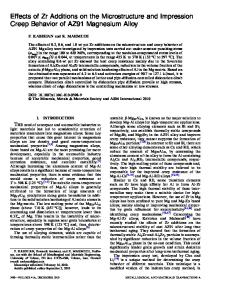Effects of Sr and B addition on microstructure and mechanical properties of AZ91 magnesium alloy
- PDF / 371,635 Bytes
- 6 Pages / 585 x 783 pts Page_size
- 16 Downloads / 365 Views
The effects of Sr and B addition on the microstructure and mechanical properties of AZ91 alloy were studied. The results of this work show that a small amount of Sr addition to AZ91 refined the grain size. The highest tensile strength was obtained from the alloy with the optimal composition of 0.5% Sr and 0.09% B added, in which the average grain size was 42 m. The tensile strength and elongation of the AZ91–0.5%Sr–0.09%B alloy were 151 MPa and 1.62%, respectively. Some needle-shaped Al4Sr particles distributed mainly at grain boundaries have been observed in the alloys with Sr and B additions. The fluidity is improved significantly, and the solidification range decreased by adding Sr and B. The liquidus of AZ91 alloy decreased markedly with the addition of Sr and B, but the solidus hardly changed. Therefore, the solidification range can be decreased, which will improve the die-casting properties.
I. INTRODUCTION
As the lightest structural alloys, magnesium alloys offer several good characteristics: high specific strength and stiffness, good electromagnetic shielding, superior damping capacity, etc.1,2 In recent years, the research and development of magnesium alloys has been driven by the automotive industry’s requirement for light weight.3 AZ91 alloy is the most widely used die-casting magnesium alloy, with applications in the automobile industry, for example. It offers good castability and mechanical properties in combination with weight reduction.4 However, the applications for this alloy are limited by the disadvantages of low elastic modulus and low toughness due to few slip systems, which are available in a hexagonal close-packed structure.5 Recently, it has been reported the addition of Sr to magnesium can not only increase the strength but also improve the creep resistance because of grain refinement.1,6,7 However, the tensile strength at room temperature in developed Mg–Al–Sr alloy was lower than that in Mg–Al–Zn alloys. Chen et al. have investigated the effects of B on microstructure and mechanical properties of Mg–Al alloy. It was found that the as-cast microstructure and average grain size are remarkably refined with trace B addition, exhibiting more strongly refining effects with increase in the B content.8,9 a)
Address all correspondence to this author. e-mail: [email protected] DOI: 10.1557/JMR.2007.0331 J. Mater. Res., Vol. 22, No. 9, Sep 2007
http://journals.cambridge.org
Downloaded: 16 Feb 2015
Therefore, an attempt was made in this study to describe the effects of Sr and B addition .We focused on the development of conventional cast Mg–Al–Zn alloys, AZ91 magnesium alloy. In addition, we investigated the optimal amount of additional elements of Sr and B to AZ91 magnesium alloy.
II. EXPERIMENTAL
Seven alloys (the compositions of which are listed in Table I) were prepared in a mild steel crucible under the protection of a mixed gas atmosphere of SF6 (1 vol%) and CO2 (balance). The base composition of the alloys studied was Mg–9.2Al–0.7Zn–0.2Mn (alloy 1) conforming to that of AZ91. Sr additio
Data Loading...











